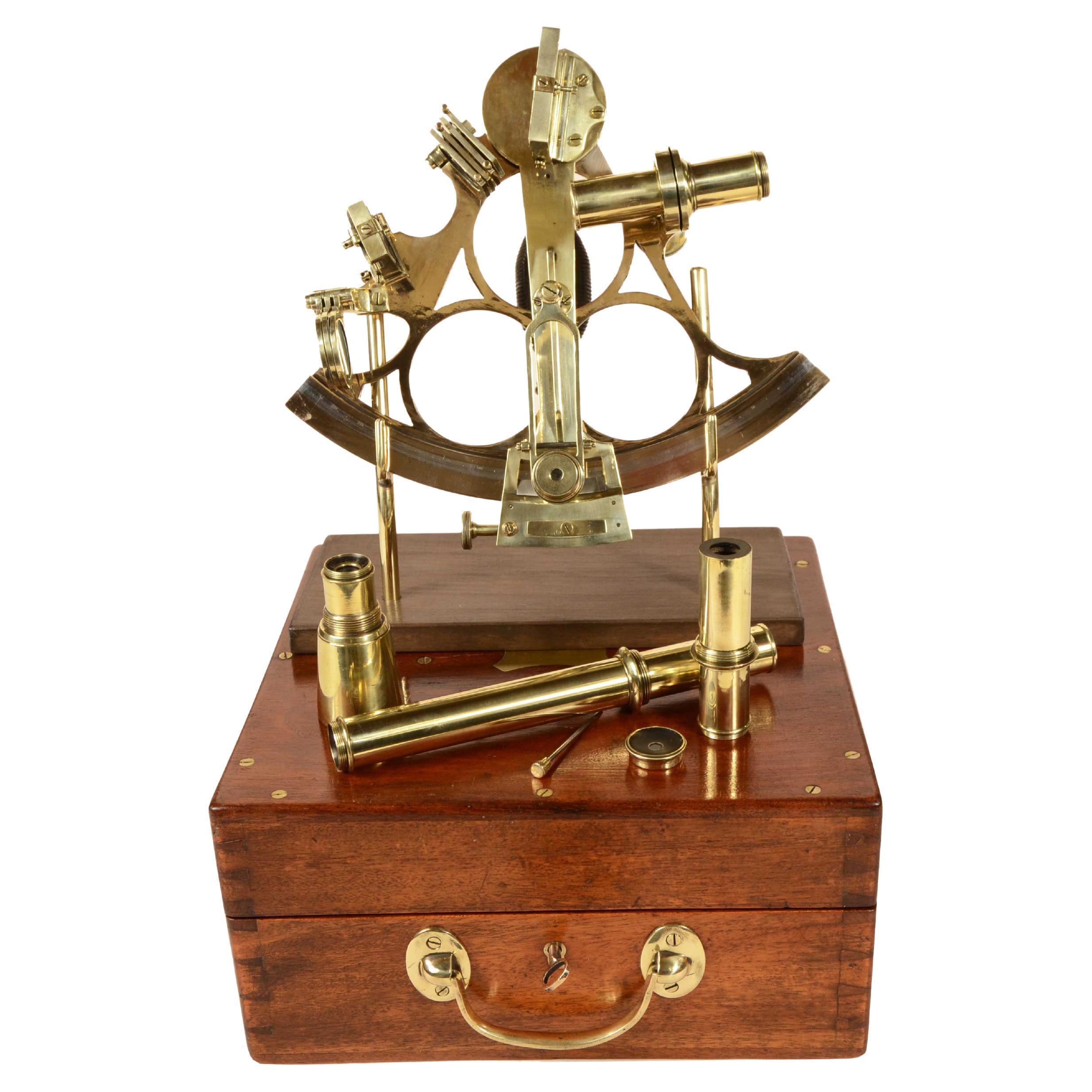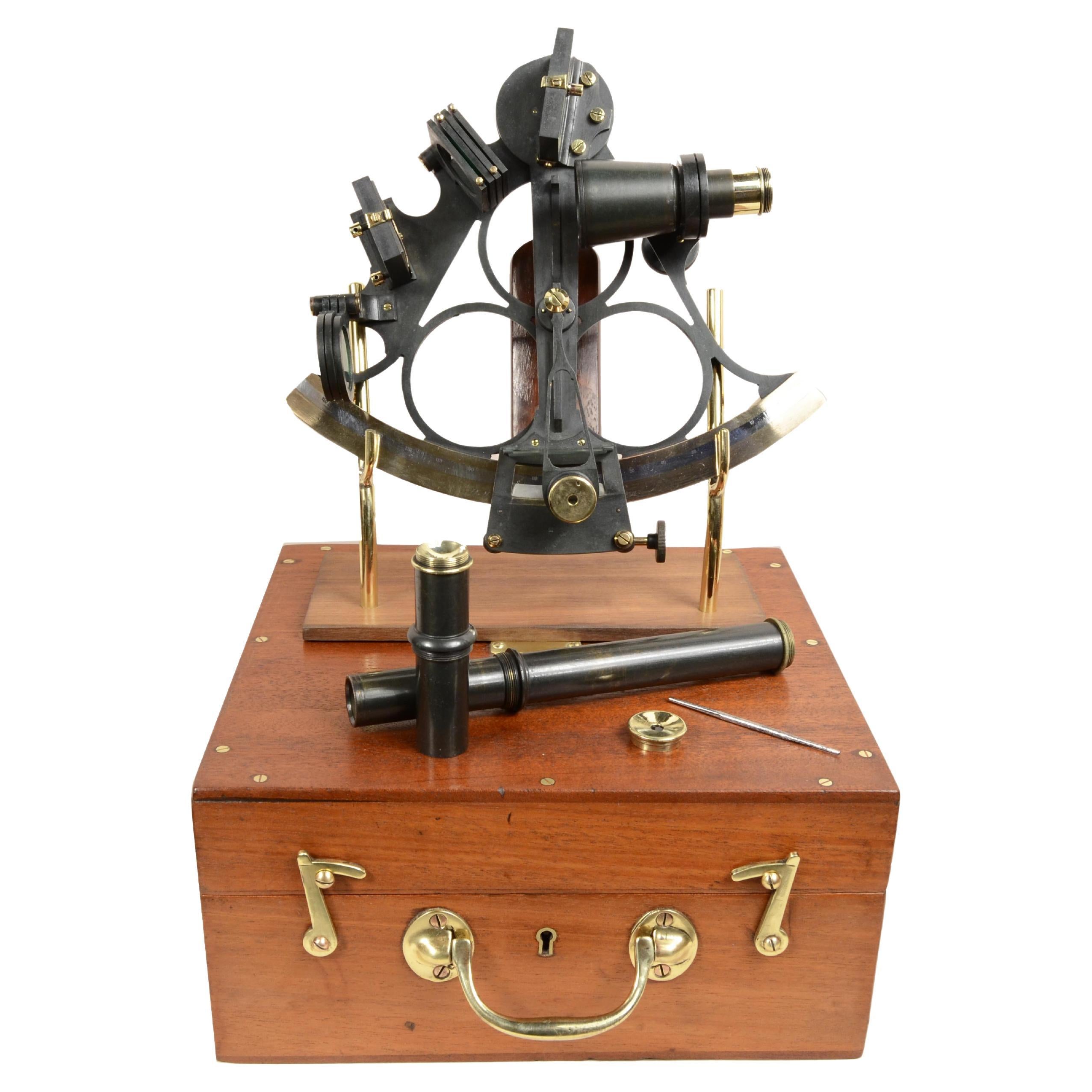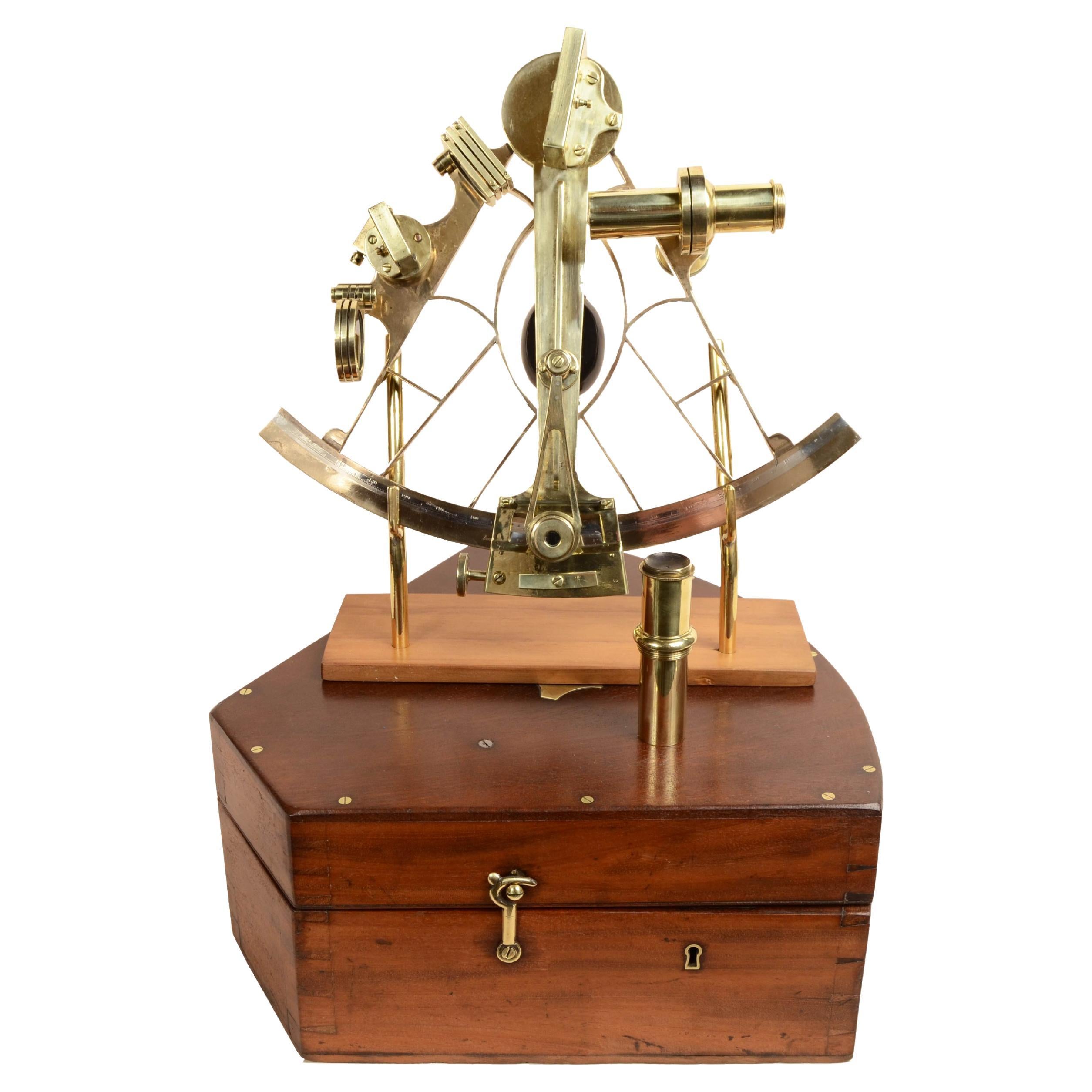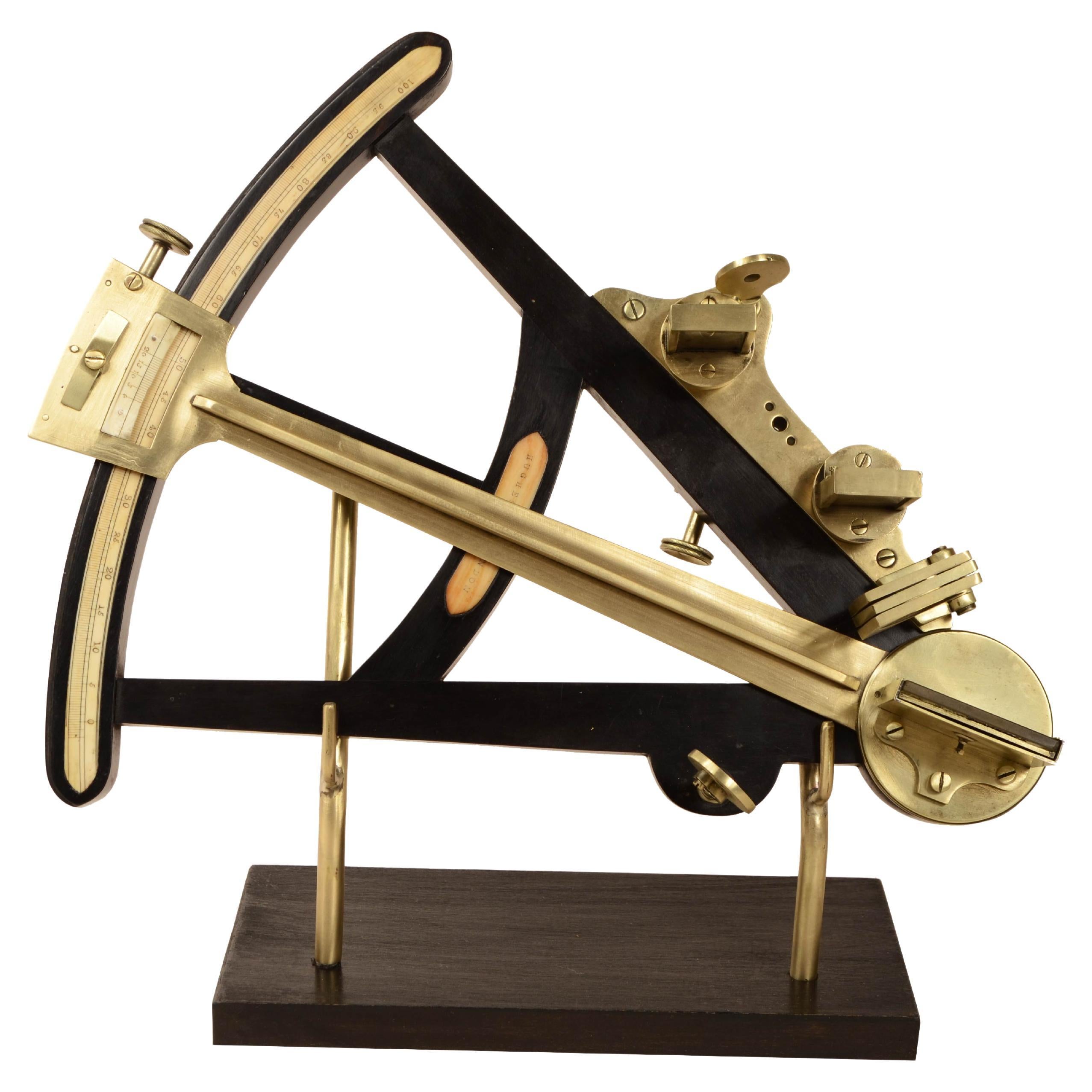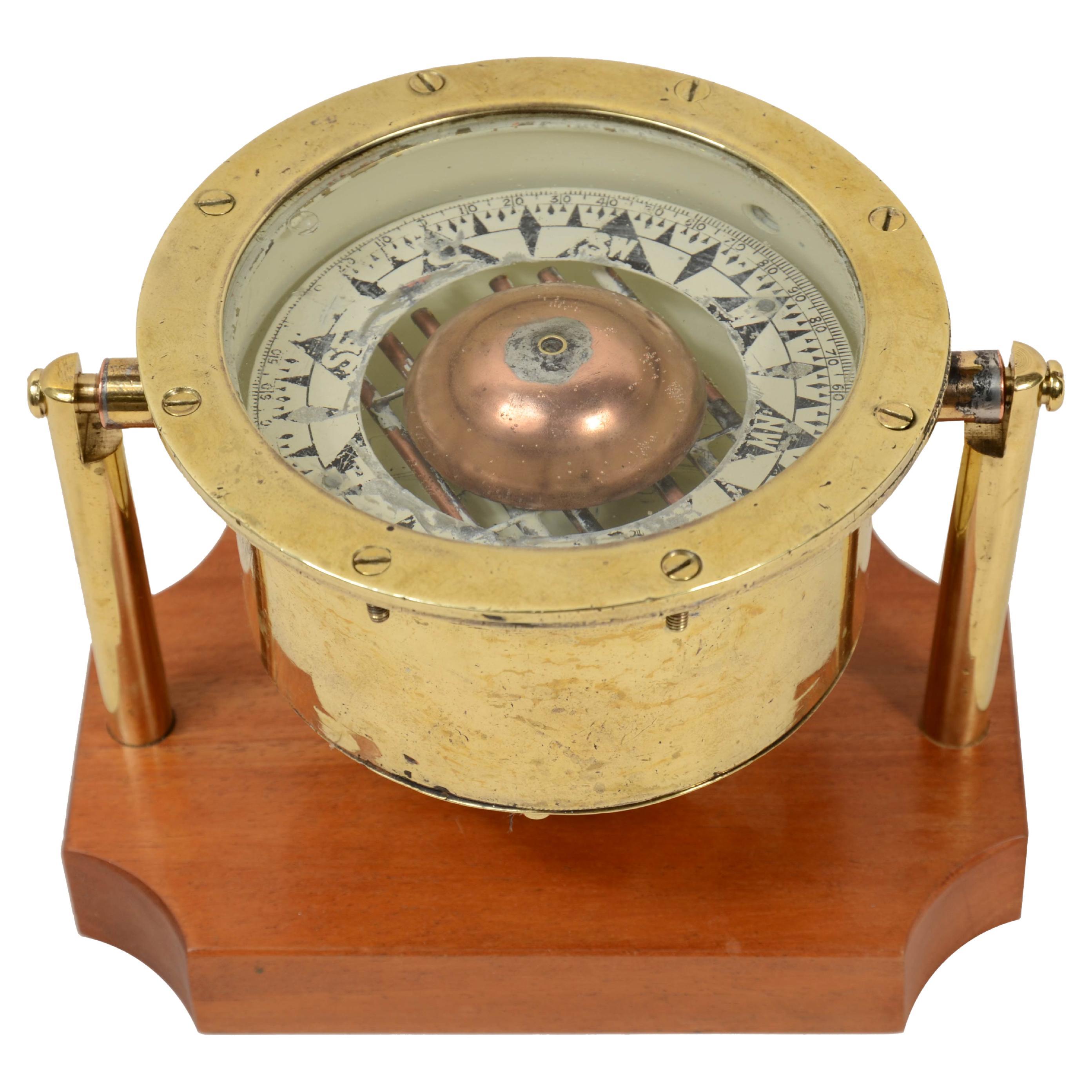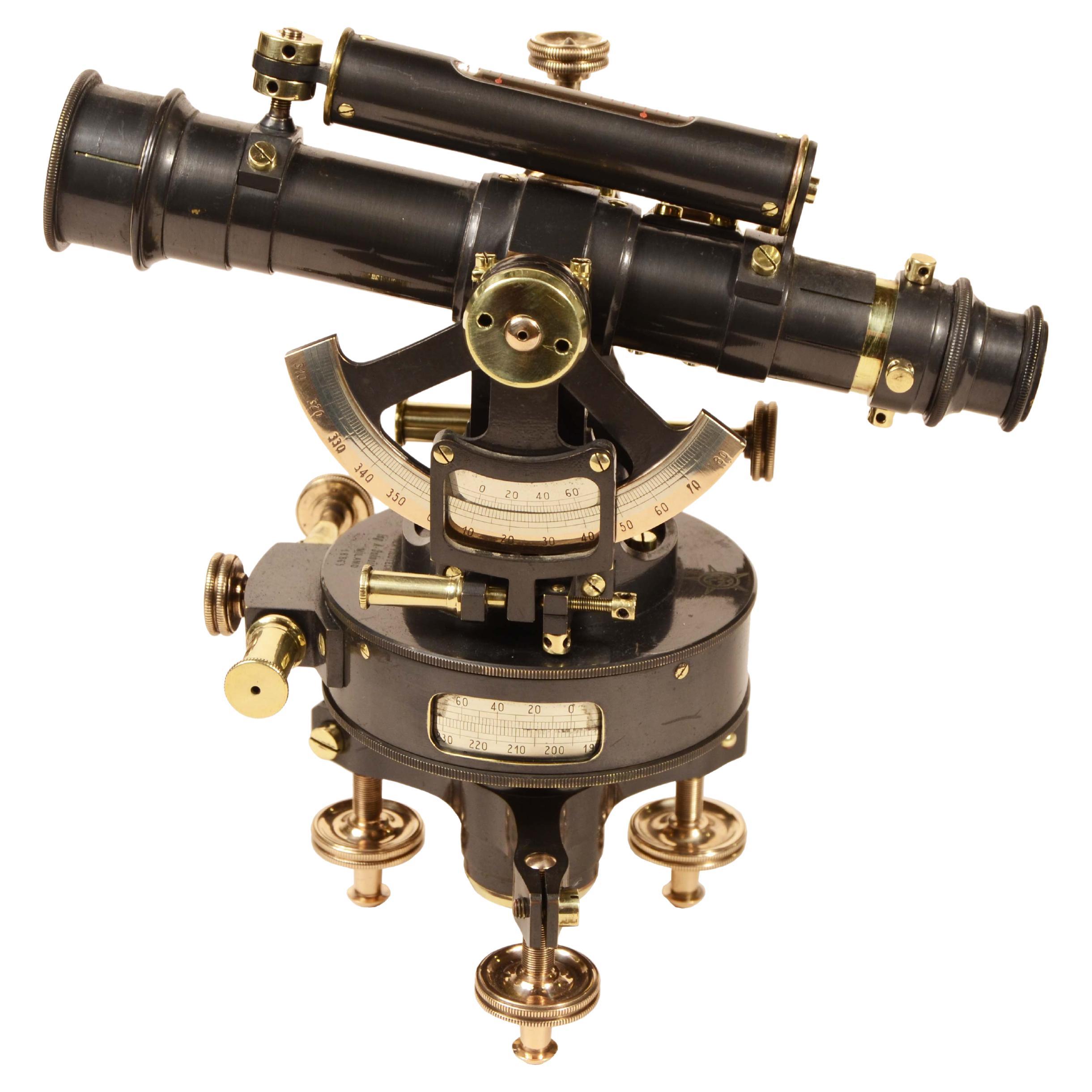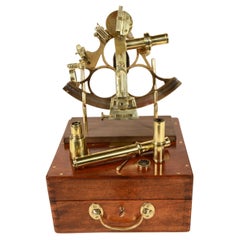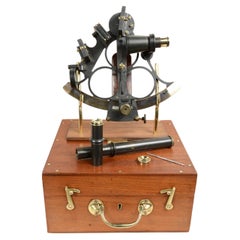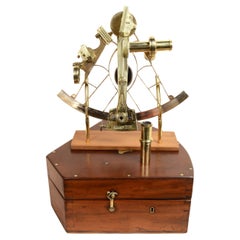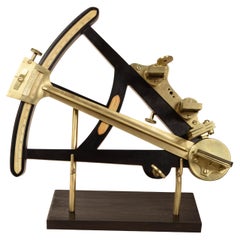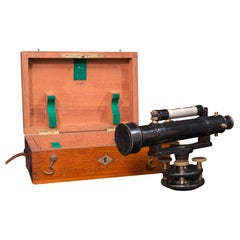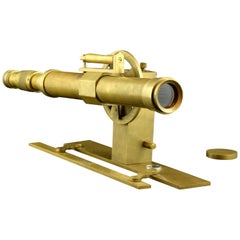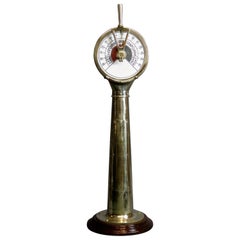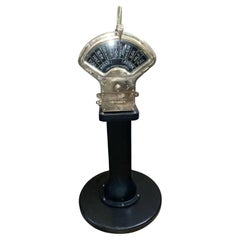Items Similar to Brass sextant signed H. Hughes & Son Ltd No. 32890 of the 1930s
Want more images or videos?
Request additional images or videos from the seller
1 of 21
Brass sextant signed H. Hughes & Son Ltd No. 32890 of the 1930s
$2,582.12
£1,901.73
€2,150
CA$3,512.77
A$3,903.47
CHF 2,045.46
MX$47,869.05
NOK 26,088.62
SEK 24,543.22
DKK 16,367.62
Shipping
Retrieving quote...The 1stDibs Promise:
Authenticity Guarantee,
Money-Back Guarantee,
24-Hour Cancellation
About the Item
Brass sextant signed H. Hughes & Son Ltd No. 32890 of the 1930s; instrument complete with optics and housed in its original mahogany wood box of with locking hooks and brass handle, complete with key lock. Brass frame with engraved silver goniometer scale recessed in the arch, with scale from 0 to + 130°, micrometer-adjustable screw-down vernier with built-in illumination and reading nonius, ebonite handle containing batteries for night lighting.
Four colored glasses for the fixed mirror and three for the movable mirror, index and 'horizon mirror, three telescopes, one of which is long, adjustment key and a filter.
Box size 26x27.3x14.5 cm - inches 10.2x10.8x5.4
Conservation status: good fully functional and complete with stand base made of custom wood and brass.
The last photo is the gift box.
The firm founded by Henry Hughes around 1830 became H. Hughes & Son in 1875, and H. Hughes & Son Ltd in 1903. After merging in 1947 with Kelvin, Bottomley & Baird Ltd, the firm became Kelvin & Hughes Ltd.
You place the instrument in a vertical plane and, looking through the sighting device, aim at the horizon line visible through the non-silvered half of the fixed mirror. Moving the alidade, with which the mirror is integral, causes the light rays coming from the star and subsequently reflected by the moving mirror and the silvered half of the fixed mirror to be sent back by the latter in the direction of observation: if you look through the aiming device you can see the image of the star, obtained by double reflection, coincide with the horizon line. The height of the astro is expressed by the angle whose value is read on the graduated scale. The filter is used when the star to be looked at is the Sun.
The sextant is an optical instrument used in astronomical navigation to measure the height of the stars on the horizon in order to derive geographical coordinates relative to the ship's point. It is in the shape of a circular sector of 60°, that is, one-sixth of a circumference, hence the name, at the apex of which is pivoted a movable alidade on which is fixed a mirror that rotates with it. On the back of the mirror is a stand with a telescope oriented toward a second mirror, only one half of which is silvered, making it possible to simultaneously observe the sea horizon, in alignment, and the pointed star, whose image is reflected by the mirror attached to the alidade and subsequently by the silvered part of the mirror. By adjusting the position of the index of the alidade, it is possible to collimate the image of the horizon with that of the star and to derive on the graduated scale of the 60° sector the angle between the horizon and the star. To make a sextant measurement of the height of a star (for example, the Sun), one places the instrument in a vertical plane and, looking through the sighting device, aims at the horizon line visible through the unsilvered half of the fixed mirror. Moving the alidade, with which the mirror is integral, causes the light rays coming from the star and subsequently reflected by the moving mirror and the silvered half of the fixed mirror to be sent back by the latter in the direction of observation: if you look through the aiming device, you see the image of the star, obtained by double reflection, coincide with the horizon line. The height of the astro is expressed by the angle whose value is read on the graduated scale. The filter is used when the star to be looked at is the Sun.
Was Sir Isaac Newton who invented the principle of double reflection in navigation instruments, but this research was never published. Subsequently, two men, independently of each other, discovered the sextant around 1730: John Hadley (1682-1744), an English mathematician, and Thomas Godfrey, (1704-1749), an American inventor. But it was not until 1758 that Admiral John Campbell conducted a series of sea trials to test a new method that relied on lunar distance as a means of calculating longitude. This is how the sextant was developed. Initially made of brass, they had scales divided with great precision by mathematicians who built scientific instruments.
About the Seller
5.0
Vetted Professional Seller
Every seller passes strict standards for authenticity and reliability
Established in 1999
1stDibs seller since 2014
397 sales on 1stDibs
Typical response time: 1 hour
- ShippingRetrieving quote...Shipping from: Milan, Italy
- Return Policy
Authenticity Guarantee
In the unlikely event there’s an issue with an item’s authenticity, contact us within 1 year for a full refund. DetailsMoney-Back Guarantee
If your item is not as described, is damaged in transit, or does not arrive, contact us within 7 days for a full refund. Details24-Hour Cancellation
You have a 24-hour grace period in which to reconsider your purchase, with no questions asked.Vetted Professional Sellers
Our world-class sellers must adhere to strict standards for service and quality, maintaining the integrity of our listings.Price-Match Guarantee
If you find that a seller listed the same item for a lower price elsewhere, we’ll match it.Trusted Global Delivery
Our best-in-class carrier network provides specialized shipping options worldwide, including custom delivery.More From This Seller
View AllBrass sextant signed B. Cooke & Son Hull from the second half of the 19th century
Located in Milan, IT
Brass sextant signed B. Cooke & Son Hull, from the second half of the 19th century and housed in its original mahogany wood box with brass handle, hinges, and locking hooks, complete...
Category
Antique 1870s Nautical Objects
Materials
Brass
Burnished brass sextant D. Mc Lean & Co Lta 113 Frenchurch St. London 1890
Located in Milan, IT
Burnished brass sextant D. Mc Lean & Co Lta 113 Frenchurch St. London, datatable around the end of the 19th century, instrument complete with optics and housed in its original squa...
Category
Antique 1890s Nautical Objects
Materials
Brass
Brass sextant signed Imray & Son 89 & 102 Minories London mid-19th century
Located in Milan, IT
Brass sextant signed Imray & Son 89 & 102 Minories London, datable to around mid-19th century, instrument housed in its original mahogany box shaped like the instrument with hinges, ...
Category
Antique Mid-19th Century Nautical Objects
Materials
Brass
Ebony, brass octant signed Hughes London made around 1830
Located in Milan, IT
Ebony wood, brass and marine ivory octant, scale from 0° to 100°,signed Hughes London made around 1830.
Good condition, complete with custom-made display base made of wood and brass....
Category
Antique 1830s Nautical Objects
Materials
Wood
Bussola a liquido su giunto cardanico e montata su tavola di legno di mogano
Located in Milan, IT
Bussola a liquido su giunto cardanico e montata su tavola di legno di mogano sagomata. Manifattura inglese della fine del XIX sec. La bussola è costituita da un recipiente di forma c...
Category
Antique Late 19th Century Nautical Objects
Materials
Brass
Tacheometro model Soldati late 19th c. signed La Filotecnica Milano
Located in Milan, IT
Tacheometer model Soldati from the late 19th century signed La Filotecnica Ing. A Salmoiraghi Milan serial no. 18865.
Construction site surveying and tracking tool used for calculati...
Category
Antique Late 19th Century Scientific Instruments
Materials
Brass
You May Also Like
Vintage Surveyor's Level, Brass, Scientific Instrument, Engineering, Circa 1950
Located in Hele, Devon, GB
This is a vintage surveyor's level. An English, brass scientific instrument with enamelled finish, dating to the mid 20th century, circa 1950.
Appe...
Category
Mid-20th Century British Scientific Instruments
Materials
Brass
Decorative Alidade, Metal, 20th Century
Located in Madrid, ES
It has a cover to protect the lens made of the same gold metal in which the rest of the instrument is made. The lines, pure and clean, are the protagonists, and make it a great opti...
Category
20th Century Unknown Other Scientific Instruments
Materials
Metal, Other
Authentic Engine Order Telegraph
Located in Norwell, MA
Brass engine room telegraph with commands “hard left”, “hard right”, “steady”, “course” etc. Telegraph has one face-plate and brass handle. Mount...
Category
Antique Late 19th Century Nautical Objects
Materials
Brass
Siemen Brothers Ships Telegraph
Located in Norwell, MA
Solid brass "Hammerhead" ships telegraph. With faceplate from Siemens Brothers and Company Limited, London. With ahead and astern ships commands includ...
Category
Vintage 1950s North American Nautical Objects
Materials
Brass
Vintage Ships Spotlight on Pedestal
Located in Norwell, MA
Industrial lighting piece of vintage lighting. Ships spotlight which is mounted by an iron yoke onto a brass pedestal. Rewired with an electric socket. ...
Category
Vintage 1940s Nautical Objects
Materials
Aluminum, Brass
Antique Surveyor's Circumcompendium Signed Brand Frères, 1850-1880
Located in Bilzen, BE
"Antique Surveyor's Circumcompendium Signed Brand Frères, 1850-1880"
Description: Antique Surveying Circumferentor by Brand Frères
Brand Frères, Optic...
Category
Antique Mid-19th Century Belgian Other Scientific Instruments
Materials
Brass
